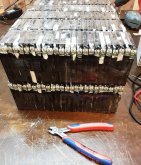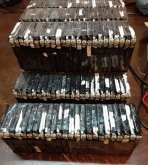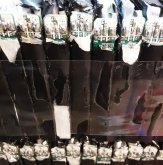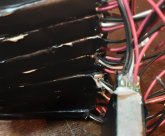heavy-impact
New Member
- Joined
- Apr 28, 2020
- Messages
- 71
I need suggestions on wiring this 36v pack made up of 240 smaller 3.6v packs. I want to keep it as compact as possible within reason.
Each cell measures 3"x2.25"x3/8" and has it's own BMS with temp sensor.
The wire I have on hand is 18ga bare tinned copper, 18ga tinned silicon insulated, 6ga insulated tinned and 105amp flat braided tinned copper strap. I have Kapton tape and shrink wrap as well.
Max output is 96 amps but I'll never draw more than 70 amps.
I have them in bundles of 24 in the picture. I was thinking 24p10s but I'll go with whatever you think is best.



I'll fab an insulated aluminum box for the pack after it's wired and have a Anderson connector fastened to the top.
_____________________________________________________________________________________________________________________________________________________________
These cells do not come as advertised on batteryhookup https://batteryhookup.com/products/3-7v-4-4ah-16-28wh-w-bms-no-wires. They advertise them with two 2a BMSs mounted on top each pack with the solder pads easy to reach.
What you see in the pics on the right is what you really get with a single 4a side mount BMS wires randomly attached on them (even though you order no wires) and strong glue and fiber tape covering all solder pads. Batteryhookup ignored all emails about this and never changed their advertisement. I wasted days cleaning these up to make them usable. I'm not angry, just disappointment in being mislead. I'll still do business with them but I know to ask questions now. Everything else I've ordered from them has been as advertised.



Each cell measures 3"x2.25"x3/8" and has it's own BMS with temp sensor.
The wire I have on hand is 18ga bare tinned copper, 18ga tinned silicon insulated, 6ga insulated tinned and 105amp flat braided tinned copper strap. I have Kapton tape and shrink wrap as well.
Max output is 96 amps but I'll never draw more than 70 amps.
I have them in bundles of 24 in the picture. I was thinking 24p10s but I'll go with whatever you think is best.



I'll fab an insulated aluminum box for the pack after it's wired and have a Anderson connector fastened to the top.
_____________________________________________________________________________________________________________________________________________________________
These cells do not come as advertised on batteryhookup https://batteryhookup.com/products/3-7v-4-4ah-16-28wh-w-bms-no-wires. They advertise them with two 2a BMSs mounted on top each pack with the solder pads easy to reach.
What you see in the pics on the right is what you really get with a single 4a side mount BMS wires randomly attached on them (even though you order no wires) and strong glue and fiber tape covering all solder pads. Batteryhookup ignored all emails about this and never changed their advertisement. I wasted days cleaning these up to make them usable. I'm not angry, just disappointment in being mislead. I'll still do business with them but I know to ask questions now. Everything else I've ordered from them has been as advertised.



Last edited:





